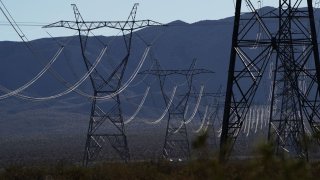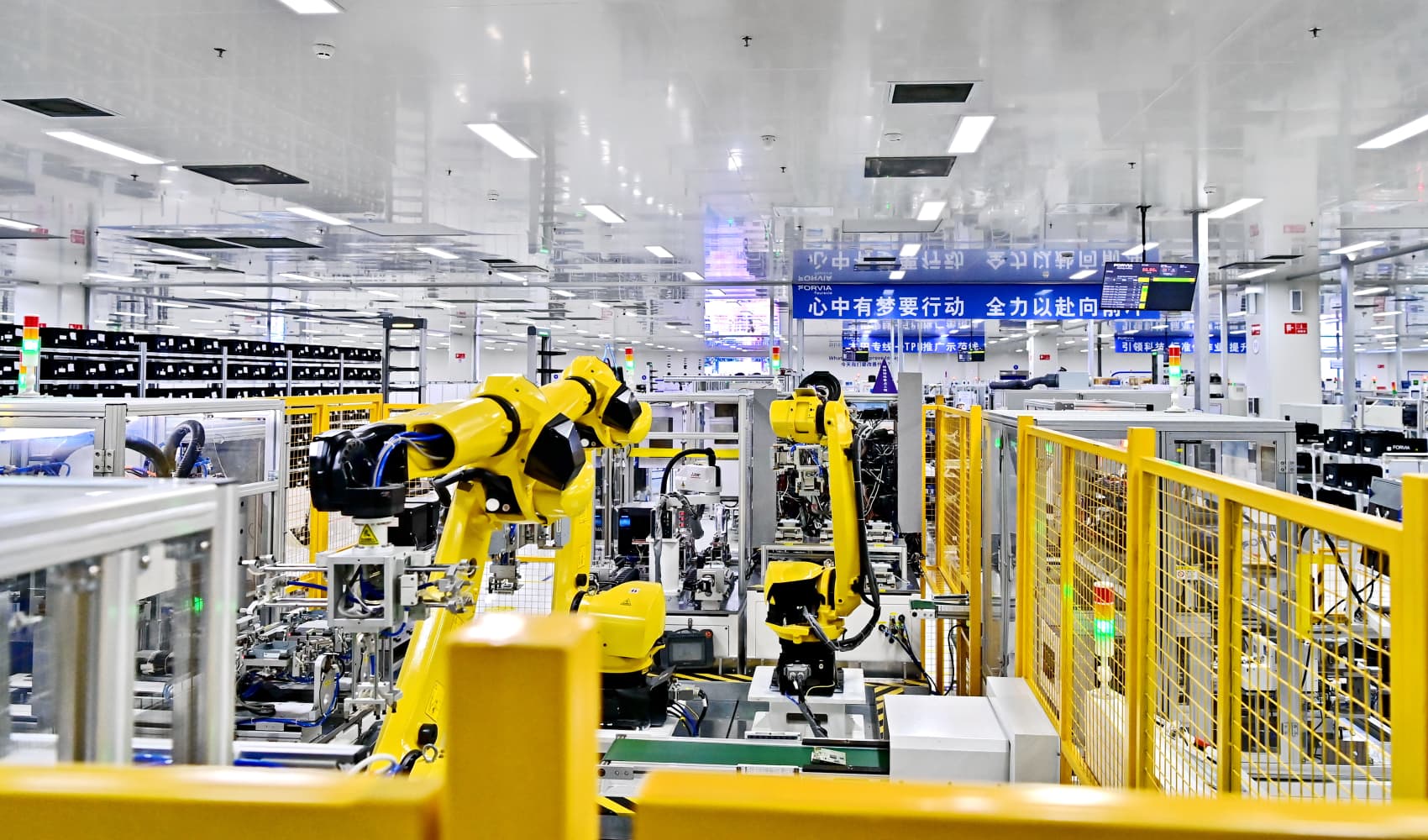
Power lines and transmission towers near the Ivanpah Solar Electric Generating System in the Mojave Desert in San Bernardino County, California, U.S., on Saturday, Feb. 19. 2022.
- Data centers in the U.S. could consume as much electricity by 2030 as some entire industrialized economies.
- The power demand from data centers is expected to soar just as a growing number of coal plants are retired as part of the transition away from fossil fuels.
- The result could be a supply crunch if more power generation is not rapidly brought online.
Artificial intelligence could strain the U.S. electric grid, as power demand from data centers is poised to surge in the coming decade just as supply is falling due to the rapid retirement of coal-fired plants.
Data centers in the U.S. alone could consume as much electricity as some major industrialized economies produce by 2030, as they proliferate not just in number but also in the scale of their power needs.
The computer warehouses that power the Internet and increasingly AI could require up to 400 terawatt hours of electricity by 2030, according to an August report from Mizuho Securities.
Get top local stories in San Diego delivered to you every morning. Sign up for NBC San Diego's News Headlines newsletter.
That's more than the total electricity production of the United Kingdom in 2022, according to data from the International Energy Agency.
Data center developers are knocking at the door of the nation's utilities at the same time many of these power companies are retiring coal plants as part of the transition away from fossil fuels. But the waiting list to bring clean energy, primarily solar and wind, onto the grid to replace coal is long and renewables are less reliable.
PJM Interconnection, the largest grid operator in the U.S., warned in July that the reliability of the system is a growing concern as coal plants close faster than new power generation is built.
Money Report
PJM serves 13 states primarily in the Mid-Atlantic region, including northern Virginia, the largest data center market in the world. Resources in areas of Virginia are insufficient and the transmission system is constrained, limiting the ability to import power from elsewhere, according to PJM.
Yet data center "growth is accelerating in orders of magnitude, driven by the number of requests, the size of each facility and the acceleration of each facility's ramp schedule to reach full capacity," Dominion Energy CEO Robert Blue told investors on the company's earnings call on Aug. 1.
Electrification of economy
In addition to data centers, manufacturing is returning to the U.S. and the broader economy is electrifying. Recent auction prices to bring new power capacity to the PJM power pool have surged more than 800% as a consequence of rising demand and limited supply.
"The market has already made one transition from coal to gas," Susan Buehler, a spokesperson for PJM, told CNBC. "We see this energy transition is here. We just see that the forces around it are happening faster than the renewable energy transition is happening."
"So we see a potential gap, and that's what the market is signaling," Buehler said.
PJM has forecast that electricity demand surge will surge nearly 40% by 2039 in its 369,000-square mile service area. Meanwhile, 40 gigawatts of existing power generation is at risk of retirement by 2030, or about 21% of PJM's current installed capacity.
While there are 290 gigawatts of renewable projects waiting to get connected to the grid, in the past only about 5% of such projects have actually been built, according to PJM.
About 38 gigawatts of renewable energy have been approved for connection and another 72 gigawatts are coming in the first quarter of 2025, Buehler said, but the projects are not being built quickly enough due the challenges developers are facing on the ground.
Buehler said developers "can't get their projects sited, there are supply chain delays, and there are financing issues."
Step-change in investment needed
Utilities that operate in PJM have disclosed at least 50 gigawatts of potential data center demand during their recent earnings calls, though CEOs have cautioned there could be some duplication in the numbers.
About 29% of current data center electricity demand in the U.S. is located within PJM's territory, according to Mizuho. Some 25% of data center power demand in the nation is in Virginia.
American Electric Power, one of the largest electric utilities in the U.S., has commitments for more than 15 gigawatts of demand from data centers through the end of the decade, interim CEO Benjamin Fowke told investors on the company's second-quarter earnings call earlier last month.
That level of demand is equivalent to more than 40% of the peak electric load of 35 gigawatts across AEP's entire system at the end of last year, according to Fowke. AEP serves 5.6 million customers in 11 states in the Midwest and South.
"These are far from just inquiries," Fowke told investors. "These are serious customers that want to get on the grid and are willing to financially commit to do what it takes to get on the grid."
Fowke testified to Congress in May that demand for electricity in some parts of the U.S. is already outstripping available capacity on the grid. The former CEO of Xcel Energy said that requests from large customers would more than double the current peak demand on the utility's system.
"It took over 100 years of planning and building to create our current system, and a step-change in infrastructure investment on an accelerated timeline will be required to serve even a fraction of this future demand in a reliable manner," Fowke told the Senate Committee on Energy and Natural Resources.
The cost of building new infrastructure to meet the demand is expected to reach hundreds of billions of dollars, Fowke said.
In the past, a large manufacturing facility might need 100 megawatts of electricity — equivalent to about 100,000 homes, Fowke told Congress. It is now increasingly common for a single data center to need anywhere from three to 15 times that amount of power, the CEO said.
Dominion Energy regularly gets requests to support data center campuses that require as much as several gigawatts of power, Blue said in May. That's larger than the average capacity of a nuclear reactor in the U.S.
Going around the grid
One of the many challenges in connecting this kind of demand to the grid is that it can take up to a decade to decide the exact route a transmission line will take, get the necessary permits and build it, Edison Electric Institute senior vice president for customer solutions Phil Dion told Congress in June.
As a result, tech companies that are building data centers are increasingly looking at directly connecting their facilities to large power resources, such as nuclear plants, rather than waiting to access the grid. But that approach is already facing controversy.
Amazon Web Services purchased a data center campus in March from Talen Energy for $650 million that will be powered directly by the Susquehanna nuclear plant in Pennsylvania. It was viewed by some in the industry as a landmark agreement that could pave the way for more nuclear-powered data centers.
But AEP has challenged the agreement before the Federal Energy Regulatory Commission, warning that such arrangements could further constrain supply on the electric grid.
Constellation Energy CEO Joe Dominguez told investors earlier this month that hooking data centers directly to nuclear reactors is the fastest and most cost effective solution. Constellation operates the largest portfolio of nuclear plants in the U.S.
"The notion that you could accumulate enough power somewhere on the grid to power a gigawatt data center is frankly laughable to me," Dominguez said on Constellation's August earnings call.
Utility executives have warned that failure to meet rising demand from data centers could affect the entire U.S. economy.
"If I can't get that power capacity online, I cannot do the data center. I cannot do the manufacturing. I can't grow the core businesses of some of the largest corporations in the country," Petter Skantze, vice president of infrastructure development at NextEra Energy Resources, the renewable energy unit of NextEra Energy, said at a conference in New York City in June.
"The stakes are really, really high," Skantze said. "This is a new environment. We have to get this right."






